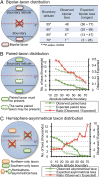Marine bacteria exhibit a bipolar distribution
- PMID: 23324742
- PMCID: PMC3568360
- DOI: 10.1073/pnas.1212424110
Marine bacteria exhibit a bipolar distribution
Abstract
The microbial cosmopolitan dispersion hypothesis often invoked to explain distribution patterns driven by high connectivity of oceanographic water masses and widespread dispersal ability has never been rigorously tested. By using a global marine bacterial dataset and iterative matrix randomization simulation, we show that marine bacteria exhibit a significantly greater dispersal limitation than predicted by our null model using the "everything is everywhere" tenet with no dispersal limitation scenario. Specifically, marine bacteria displayed bipolar distributions (i.e., species occurring exclusively at both poles and nowhere else) significantly less often than in the null model. Furthermore, we observed fewer taxa present in both hemispheres but more taxa present only in a single hemisphere than expected under the null model. Each of these trends diverged further from the null expectation as the compared habitats became more geographically distant but more environmentally similar. Our meta-analysis supported a latitudinal gradient in bacterial diversity with higher richness at lower latitudes, but decreased richness toward the poles. Bacteria in the tropics also demonstrated narrower latitudinal ranges at lower latitudes and relatively larger ranges in higher latitudes, conforming to the controversial macroecological pattern of the "Rapoport rule." Collectively, our findings suggest that bacteria follow biogeographic patterns more typical of macroscopic organisms, and that dispersal limitation, not just environmental selection, likely plays an important role. Distributions of microbes that deliver critical ecosystem services, particularly those in polar regions, may be vulnerable to the same impacts that environmental stressors, climate warming, and degradation in habitat quality are having on biodiversity in animal and plant species.
Conflict of interest statement
The authors declare no conflict of interest.
Figures





References
-
- Hooker JD. The Botany of the Antarctic Voyage of H. M. Discovery Ships Erebus and Terror, in the Years 1839-1843. London: Reeve Brothers; 1847.
-
- Ross JC. A Voyage of Discovery and Research in the Southern and Antarctic Regions, during the Years 1839-43. London: John Murray; 1847.
-
- Darling KF, et al. Molecular evidence for genetic mixing of Arctic and Antarctic subpolar populations of planktonic foraminifers. Nature. 2000;405(6782):43–47. - PubMed
-
- Montresor M, Lovejoy C, Orsini L, Procaccini G, Roy S. Bipolar distribution of the cyst-forming dinoflagellate Polarella glacialis. Polar Biol. 2003;26:186–194.
Publication types
MeSH terms
Substances
LinkOut - more resources
Full Text Sources
Other Literature Sources

